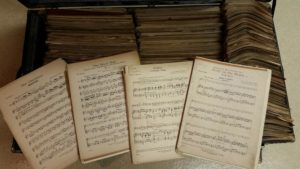
One of Bill’s footlockers
1979 LAYING GROUNDWORK At least 2 personal projects in 1979 laid groundwork for the future. Bill and Garry tried a couple new directions. During the 1970s while rummaging for xylophone music, Bill had found several large boxes of sheet music in a Rochester antique shop. The hundreds of titles had been published in the early 1900s and he soon realized it was all orchestrated for small (12-piece) orchestras. In Rochester alone there had been up to a dozen silent movie houses downtown with films accompanied by live orchestras. Bill’s percussion teacher at Eastman, William Street, had been in one of those orchestras, providing percussion accompaniment and sound effects. Bill was hooked, and in a few short years had accumulated a huge theater orchestra library. Then (Bill says), “In 1979 I formed and conducted the Rochester Theatre Orchestra, which throughout the 1980s presented programs in the Rochester region comprised entirely of music from my theater orchestra library.” This interest would eventually evolve into a program for NEXUS called “From Rags to Riches” and NEXUS’ silent film accompaniments. As of 2018, the entire library lives with the Peacherine Ragtime Society Orchestra, based in Maryland.
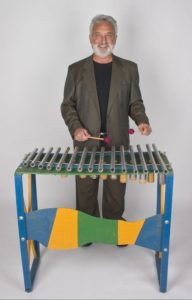
Garry playing adapted lawn chair
Meanwhile, our future NEXUS member, Garry Kvistad, joined Steve Reich and Musicians in ’79, joining Russell and Bob – They would tour and record with SR&M for nearly 40 years. Something else happened to Garry in ’79: he created his first chime! He was 28 and he and Blackearth were in residence at University of Cinncinnati. Garry was fascinated with the music of ancient civilizations and while researching for his master’s, discovered Harry Partch’s ratios of a scale used by the 7th century BCE Greek musician Olympos. But to hear this scale he would have to build an instrument! “One of the easiest ways of recreating the scale for me was to tune a set aluminum tubes since the only factor in determining the notes was the length of the tubes and I knew the formulas for length and frequency from my study of physics. My first experiments used the tubes from old lawn chairs, played like a xylophone. But I wanted to share this amazing discovery with others…the idea of a set of windchimes came to me. I headed to the basement of our apartment and stayed up into the wee hours, making my first windchime to the scale of Olympos. I used everything I learned in College to not only tune it correctly but to make sure the laws of musical acoustics were taken into consideration: where the tube was struck, where the tube was suspended, what kind of wood was used to strike the tube, etc.” Ten years later, Takemitsu would commission Garry to create the giant chimes for the NEXUS concerto “From me flows what you call Time…”
Read/hear more: Garry’s TEDx Talk on The First Chime: https://bit.ly/3fiFMNA ; Birth of Woodstock Chimes: https://www.nexuspercussion.com/2013/07/the-birth-of-woodstock-chimes/ ; Bill’s RTO collection: https://www.nexuspercussion.com/2018/11/tale-of-a-library/
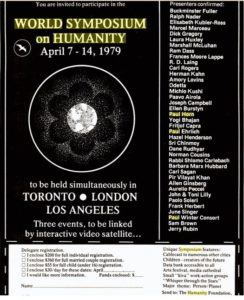 1979 NATO and HUMANITY Two unusual events! We began the year performing an improvisation with Paul Horn at the World Symposium on Humanity: “Three Simultaneous Events : Los Angeles, Toronto, London [Eng.] : Linked by Live Video Satellite Broadcast : Featuring the Planet’s Most Outstanding Teachers, Leaders, Scientists, Performers and Artists, April 7-14, 1979”. At the Toronto event, Allen Ginsberg read his Plutonian Ode and other “beat poems”. Scroll down for a link to hear him. A “Getty Images” offering from the U.K. event is titled “Hippie at the 1979 WSH”. We ended the year performing at the National Arts Centre in Ottawa at the Gala Performance for the 25th
1979 NATO and HUMANITY Two unusual events! We began the year performing an improvisation with Paul Horn at the World Symposium on Humanity: “Three Simultaneous Events : Los Angeles, Toronto, London [Eng.] : Linked by Live Video Satellite Broadcast : Featuring the Planet’s Most Outstanding Teachers, Leaders, Scientists, Performers and Artists, April 7-14, 1979”. At the Toronto event, Allen Ginsberg read his Plutonian Ode and other “beat poems”. Scroll down for a link to hear him. A “Getty Images” offering from the U.K. event is titled “Hippie at the 1979 WSH”. We ended the year performing at the National Arts Centre in Ottawa at the Gala Performance for the 25th
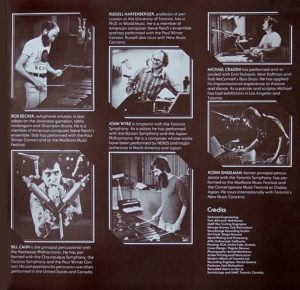
Inside cover of rag album
anniversary of the North Atlantic Assembly. Founded in 1955, the Assembly serves as “the consultative interparliamentary organisation” for the North Atlantic Alliance. Robin recalled Bill Cahn visiting him not long after and listening together to the playback of the NEXUS performance over a glass of very fine wine. We also released a second edition of the “NEXUS Ragtime Concert” LP on the UltraFi label; it utilised “takes” that were different from the original 1976 LP. See cover photos. This was also the year of our first Quebec provincial tour. But John and Robin were unavailable due to Toronto Symphony duties, so we toured as a quartet with the wonderful Beverley Johnston as guest artist.
Read/hear more: The NAA: https://en.wikipedia.org/wiki/NATO_Parliamentary_Assembly
Allen Ginsberg in Toronto 1979: https://allenginsberg.org/2015/02/1979-allen-ginsberg-reading-in-toronto-plutonian-ode-other-poems/
Getty Image for the UK WSH: https://www.gettyimages.ca/detail/photo/hippie-at-the-1979-world-symposium-on-high-res-stock-photography/521887322
Fine wine: www.robinengelman.com “Wine Diary”
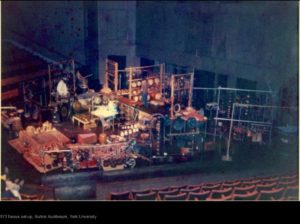
1973 set-up at York U.
1970s IMPROV INSTRUMENTS – PART 1 Robin Engelman wrote in 2006 about our improvisations: “We shared the gestures and techniques of trained Western percussionists. We had been exposed to and played Jazz, Rock and Roll, Blues, Country, Folk, Classical, Contemporary and military music. We were flexible in our music making and had a profound interest in sound. We were also close friends…Our conscious decision to collect and play instruments from other cultures was both technically and musically liberating…The sounds of these “new” instruments refreshed our ears and inspired our first informal collaborations. These improvisations had a joie de vivre. Nexus’ early free improvisation era has been credited, at least in part, with spawning new professional percussion ensembles. Yet today, all the younger percussion ensembles play written music and, to my knowledge, none of them improvise in public. As my colleague Bob Becker said, ‘People were more interested in how we played than what we played’. Nexus was an unanalyzable anomaly.” John Wyre had been an early inspiration for our instrument collecting. In a 2009 article, Stewart Hoffman recalled a visit to John’s loft: “His downtown apartment, above a hairdresser on Yonge Street south of St.Clair, was unlike anything I’d ever seen. I remember the thrill I felt walking up the narrow staircase and into a room filled with exotic instruments: Balinese nipple gongs, assorted African and Chinese drums, cymbals of all shapes and sizes, and bells hanging everywhere. He collected flowerpots too, which he’d suspended from the ceiling and would play with yarn mallets. He was in love with sound in its purist form. He also had brake drums (yes, the ones from cars; strike them and they produce a resonant “ping”) so I paid a visit to a wrecker for a set of my own. They were proudly displayed in my bedroom, and when I hit them with a mallet, bits of rust would spill onto the floor.” Bill Cahn went the route of building his own instruments for our improvising, and among his creations was a pedal operated musical saw! He wanted “access to the sustained sound of a bowed musical saw without having to take the time to sit down and assume the normal saw-playing position, which could be very disruptive in a freeform improvisation. The pedal structure was designed to hold two saws while preserving the double-bends (‘S’ bends) in the saws that are needed to obtain the characteristic singing tone. By pressing the pedal, it was possible to raise the pitch while bowing with one hand, enabling the free hand to hold another instrument or mallet, all without the need to take a seat.” In Part 2, we’ll share Bob Becker’s recollections and also Garry’s experiences with Blackearth improvisations.
Read more: Great paper given by Robin Engelman at Eastman 2006: Perspectives on Improvisation, discusses NEXUS’ approach: https://bit.ly/3h8ix9x Stewart Hoffman’s article: https://stewarthoffmanmusic.com/remembering-john-wyre/
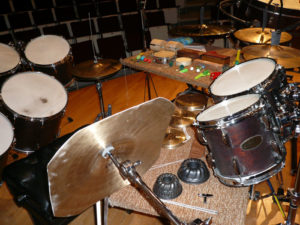
Bob’s improv set up
1970s IMPROV INSTRUMENTS – PART 2 Bob Becker says, “In the early days of Nexus many of our ‘instruments’ were various found objects – things not originally designed to be used in musical contexts. I always enjoyed browsing in hardware stores and kitchenware departments. During the ‘70s many common implements were still manufactured using quite high-quality materials. Bundt cake pans, for example, were made of very thick and heavy cast aluminum. They had a fantastic clear pitch and resonance not found in current ones. In 1970 I bought a set of seven large graduated stainless-steel mixing bowls at the old Sibley’s department store in Rochester. I spent half an hour looking through all the bowls on display until I found the ones with the best sounds. They were quite a bit more substantial than the usual type found today, and they had a marvellous ringing sound when resting upright on a padded surface. When inverted and played with vibes mallets, the flat bottoms produced a sharp metallic ping with a pronounced upward bend to the pitch. The bowls became a favourite part of my improv setup, and I continued using them for many years.”
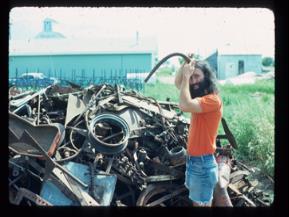
Garry at the junk yard
Garry Kvistad remembers visiting NEXUS when he was creating the Blackearth Percussion Group in 1972. He and Rick Kvistad and Al Otte “journeyed to Toronto to hang out with NEXUS. Robin and John were the only ones in town so we went to John’s studio at the conservatory (I think) where he had a great collection of instruments which we improvised on for what I remember to be hours. In the mid’60s in high school my teacher Michael Ranta introduced us to improvisation and I mostly used found “junk” instruments, and this continued into the 70’s, the Blackearth era. I spent many days in the dump (also known as the junk yard, landfill and now called the transfer station) looking for objects and materials for instruments and parts. In NEXUS improvisations I have used a number of homemade instruments starting when I joined the group in 2002. Many of them were hybrid instruments of parts given to me by Bernard Baschet, an incredible French instrument builder who worked with his brother Francois. I combined the Baschet hybrids with some of my chime creations to use in solo performances at the Woodstock Byrdcliffe Guild which included improvisations. I opened Jack DeJohnette’s 70th birthday concert in 2012 at the Bearsville Theater with a solo improvisation using these instruments. And in 2003, I filled the Kleinert/James Hall at the Woodstock Byrdcliffe Guild with instruments (many homemade) for a concert with friends which included improvisations. In the photo you will see that windchimes hung from the rafters above the audience and the Baschet hybrids are in the front of the stage. Joining me were Thad Wheeler, Frank Cassara and Mark Stewart.
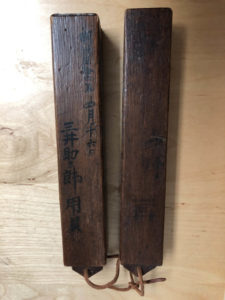 IMPROV INSTRUMENTS – PART 3: Russell Hartenberger shares his favourite collected instruments, with wonderful photos and anecdotes: On the NEXUS blog at : https://www.nexuspercussion.com/2020/07/japanese-instruments-and-improvisation/
IMPROV INSTRUMENTS – PART 3: Russell Hartenberger shares his favourite collected instruments, with wonderful photos and anecdotes: On the NEXUS blog at : https://www.nexuspercussion.com/2020/07/japanese-instruments-and-improvisation/
After posting this link on our Facebook page, Mio Chang got in touch with the following useful information about the wood blocks pictured here.
https://en.m.wikipedia.org/wiki/Wakan_Sansai_Zue
The purpose of this instrument is marking a beat to conduct many people or a sign of the starts of something. There’re many way to use of HYOSHIGI in here. In the article of Wikipedia in English is not described it well enough so here’s some examples which uses HYOSHIGI.
1. Sumo
When GYOJI (ref) calling each RIKISHI (player).
https://youtu.be/Azx38-DxvsM
2. KABUKI
The sign of beginning the show or some effects of steps of actor.
https://youtu.be/tubZszT0ia4
3. KAMI SHIBAI (storytelling with pictures)
The sign of beginning of the storytelling.
https://youtu.be/jmCEmb_Sly0
4. 火の用心 ( Hi no Youjin) warming fire
This is what you said in your post.
HYOSHIGI people uses has string to hanging from neck.
https://youtu.be/ZXson5PuL18
5. TSUKE ITA
This is very unique way to use HYOSHIGI. In the video of Kabuki a player uses HYOSHIGI tapping on the wooden board. The sounds is very effective. (Start 0:10)
https://youtu.be/tubZszT0ia4
If you are interested in Japanese instruments this is the YouTube channel of HUMIO KOIZUMI who is a teacher of ethnology of Tokyo University of Art.
https://www.youtube.com/channel/UCWWPGFZJiiIwAJ0jcR4uq9Q
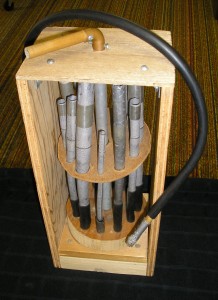
Twirlytone
1979 ORGAN PIPES FOR THE BIRDS One of our most whimsical and popular pieces is Bill Cahn’s “The Birds”, written in 1979. You can hear it on three NEXUS recordings: Voices, Best of NEXUS, and The Story of Percussion (with the Rochester Philharmonic). The piece features dozens of bird calls. At one rehearsal of the piece, with the Windsor Symphony, a real-life bird was so intrigued that he flew into the rehearsal hall from the loading dock and sat on the gong to have a listen! Bill says, “In travels around the world with NEXUS, we’ve seen and heard many types of devices intended to imitate bird calls – whistles, reed calls, wooden and slate scrapers, bellows devices, on-and-on. I have also collected dozens of such devices that have been put to good use in ‘The Birds’. In the mid 1970s, there was a major renovation of the Eastman Theatre in Rochester, and as part of that project, the old theater organ was completely removed – most of it ending up in a dumpster behind the Theatre. However, being closely connected with the stage crew, I was given access to the organ’s echo chamber, located in a cove above the chandelier and above the suspended plaster ceiling of the Theatre. The echo chamber was only accessible by climbing a very high backstage wall ladder, and then gently stepping out onto a very long steel grate catwalk that ran above the Theatre ceiling. Inside the chamber was a veritable treasure chest of organ pipes and percussion stops, all destined to be “dumpstered” unless heroically saved by caring musicians (i.e. us). I managed to salvage about 25 small pipes and percussion effects, and while writing “The Birds” I had a brainstorm. By rotating a number of the small organ pipes over a hole through which I could blow air, I might be able to create the sound effect of a warbling bird. The devise was constructed, using a rubber tube to convey the air blown from my mouth to a small hole in the wood base over which the small pipes could be rotated. It worked! And the ‘Twirlytone’ continues to be played whenever ‘The Birds is performed.”
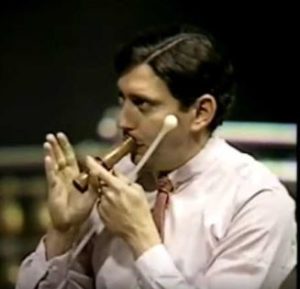
Bill playing Birds
You can watch a Birds performance at https://www.youtube.com/watch?v=A5DQdHLnYWM
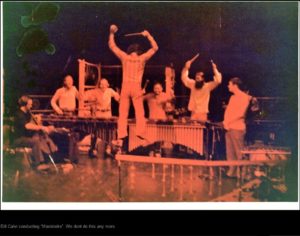 1974 MAESTROKE! From the vaults! This has emerged from Robin Engelman’s blog. It is a performance of Bill Cahn’s piece “Maestroke” – sometimes written as “My Stroke”. Because cellist David Darling and NEXUS member Michael Craden are in the photo, Bill is pretty sure this was taken at St James Cathedral, Toronto, in 1974. This was a CBC concert and David Rosenbloom was also part of that programme. The title is a pun on “maestro” of course. Bill says, “‘My Stroke’ was a conducted free improvisation. The conductor (me) improvised conducting ‘cues and phrasing’ to the players who improvised responses as they watched. It was an unmitigated ‘HOOT’. I have two observations from this photo (which I have not seen before): 1) I didn’t know I could ever jump this high; 2) Robin seems to be thinking about what he’ll be having for dinner.” Robin attached the photo as an illustration to his paper, “Perspectives on Improvisation” which he gave at Eastman in 2006, and then reproduced in his blog at robinengelman.com, and you will see that Robin added a caption to the photo: “We don’t do this any more”. Lol But it was a fun part of our repertoire in the 1970s. L to R: David Darling, Bob Becker, Russell Hartenberger, Bill Cahn, Michael Craden, John Wyre, Robin Engleman. You can read Robin’s paper at https://bit.ly/3h8ix9x
1974 MAESTROKE! From the vaults! This has emerged from Robin Engelman’s blog. It is a performance of Bill Cahn’s piece “Maestroke” – sometimes written as “My Stroke”. Because cellist David Darling and NEXUS member Michael Craden are in the photo, Bill is pretty sure this was taken at St James Cathedral, Toronto, in 1974. This was a CBC concert and David Rosenbloom was also part of that programme. The title is a pun on “maestro” of course. Bill says, “‘My Stroke’ was a conducted free improvisation. The conductor (me) improvised conducting ‘cues and phrasing’ to the players who improvised responses as they watched. It was an unmitigated ‘HOOT’. I have two observations from this photo (which I have not seen before): 1) I didn’t know I could ever jump this high; 2) Robin seems to be thinking about what he’ll be having for dinner.” Robin attached the photo as an illustration to his paper, “Perspectives on Improvisation” which he gave at Eastman in 2006, and then reproduced in his blog at robinengelman.com, and you will see that Robin added a caption to the photo: “We don’t do this any more”. Lol But it was a fun part of our repertoire in the 1970s. L to R: David Darling, Bob Becker, Russell Hartenberger, Bill Cahn, Michael Craden, John Wyre, Robin Engleman. You can read Robin’s paper at https://bit.ly/3h8ix9x
